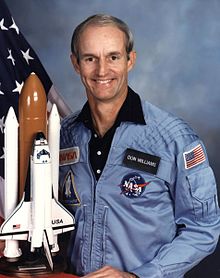- Donald E. Williams
-
For other people named Donald Williams, see Donald Williams (disambiguation).
Donald Edward Williams 
NASA Astronaut Nationality American Status Retired Born February 13, 1942
Lafayette, IndianaOther occupation Test Pilot Rank Captain, United States Navy Time in space 11d 23h 34m Selection 1978 NASA Group Missions STS-51-D, STS-34 Mission insignia 

Captain Donald Edward Williams (United States Navy, Retired) (born February 13, 1942) is a former NASA astronaut. He has logged a total of 287 hours and 35 minutes in space.
Williams was born in 1942 in Lafayette, Indiana and raised in the nearby town of Green Hill. He graduated from Otterbein High School, Otterbein, Indiana, in 1960. Williams then went on to earn a bachelor of science degree in Mechanical Engineering from Purdue University in 1964.
Contents
Organizations
Society of Experimental Test Pilots, the Association of Space Explorers, and the National Aeronautic Association.
Experience
Williams received his commission through the NROTC program at Purdue University. He completed flight training at Pensacola, Florida; Meridian, Mississippi; and Kingsville, Texas, receiving his wings in May 1966. After A-4 training, he made two Vietnam deployments aboard the USS Enterprise with Attack Squadron 113. He served as a flight instructor in Attack Squadron 125 at Naval Air Station Lemoore, California, for 2 years and transitioned to A-7 aircraft. He made two additional Vietnam deployments aboard the Enterprise with CVW-14 staff and Attack Squadron 97. Williams completed a total of 330 combat missions.
In 1973, Williams attended the Armed Forces Staff College. He graduated from the U.S. Naval Test Pilot School at Patuxent River, Maryland, in June 1974, and was assigned to the Naval Air Test Center's Carrier Suitability Branch of Flight Test Division. From August 1976 to June 1977, following reorganization of the Naval Air Test Center, he was head of the Carrier Systems Branch, Strike Aircraft Test Directorate. He reported next for A-7 refresher training and was assigned to Attack Squadron 94 when selected by NASA.
He has logged more than 6,000 hours flying time, which includes 5,700 hours in jets and 745 carrier landings.
NASA Experience
Selected by NASA in January 1978, Williams became an astronaut in August 1979, qualified for assignment as a pilot on future Space Shuttle flight crews. Since then he has had various support assignments, including working at the Space Shuttle Avionics Integration Laboratory as a test pilot, and at the Kennedy Space Center participating in Orbiter test, checkout, launch and landing operations.
From September 1982 through July 1983, he was assigned as the Deputy Manager, Operations Integration, National Space Transportation System Program Office at the Johnson Space Center. From July 1985 through August 1986, Williams was the Deputy Chief of the Aircraft Operations Division at the Johnson Space Center, and from September 1986 through December 1988, he served as Chief of the Mission Support Branch within the Astronaut Office.
Twice flown, Williams served as pilot on STS-51D in 1985, and was the spacecraft commander on STS-34 in 1989.
In March 1990, Williams retired from the United States Navy and left NASA. He is currently a Division Manager with Science Applications International Corporation, working on several projects in the Houston area, nationally, and internationally.
Space Flight Experience
STS-51-D Discovery (April 12–19, 1985) was launched from and returned to land at the Kennedy Space Center, Florida. During the mission, the crew deployed ANIK-C for Telesat of Canada, and Syncom IV-3 for the United States Navy. A malfunction in the Syncom spacecraft resulted in the first unscheduled EVA, rendezvous and proximity operations for the Space Shuttle in an attempt to activate the satellite. Additional, the crew also conducted several medical experiments, two student experiments, activated two Getaway Specials, and filmed experiments with toys in space. The mission was accomplished in 109 orbits of the Earth in 167 hours, 54 minutes.
STS-34 Atlantis (October 18–23, 1989) was launched from Kennedy Space Center, Florida and returned to land at Edwards Air Force Base, California. During the mission the crew successfully deployed the Galileo spacecraft, starting its journey to explore Jupiter, operated the Shuttle Solar Backscatter Ultraviolet Instrument (SSBUV) to map atmospheric ozone, and performed numerous secondary experiments involving radiation measurements, polymer morphology, lightning research, microgravity effects on plants, and a student experiment on ice crystal growth in space. The mission was accomplished in 79 orbits of the Earth in 119 hours, 41 minutes.
See also
References
- NASA: Astronaut Biography
- Warren County Historical Society (2002), A History of Warren County, Indiana (175th Anniversary Edition)
NASA Astronaut Group 8, "TFNG (Thirty-Five New Guys)", 1978 Pilots Daniel Brandenstein · Michael Coats · Richard Covey · John Creighton · Robert Gibson · Frederick D. Gregory · Frederick Hauck · Jon McBride · Steven Nagel · Francis "Dick" Scobee · Brewster Shaw · Loren Shriver · David Walker · Donald WilliamsMission specialists Guion Bluford · James Buchli · John Fabian · Anna Fisher · Dale Gardner · S. David Griggs · Terry Hart · Steven Hawley · Jeffrey Hoffman · Shannon Lucid · Ronald McNair · Mike Mullane · George Nelson · Ellison Onizuka · Judith Resnik · Sally Ride · Rhea Seddon · Robert Stewart · Kathryn Sullivan · Norman Thagard · James van HoftenNASA Astronaut Groups · NASA Astronaut Corps Categories:- 1942 births
- Living people
- American astronauts
- United States Navy officers
- American military personnel of the Vietnam War
- Purdue University alumni
- People from Warren County, Indiana
Wikimedia Foundation. 2010.
